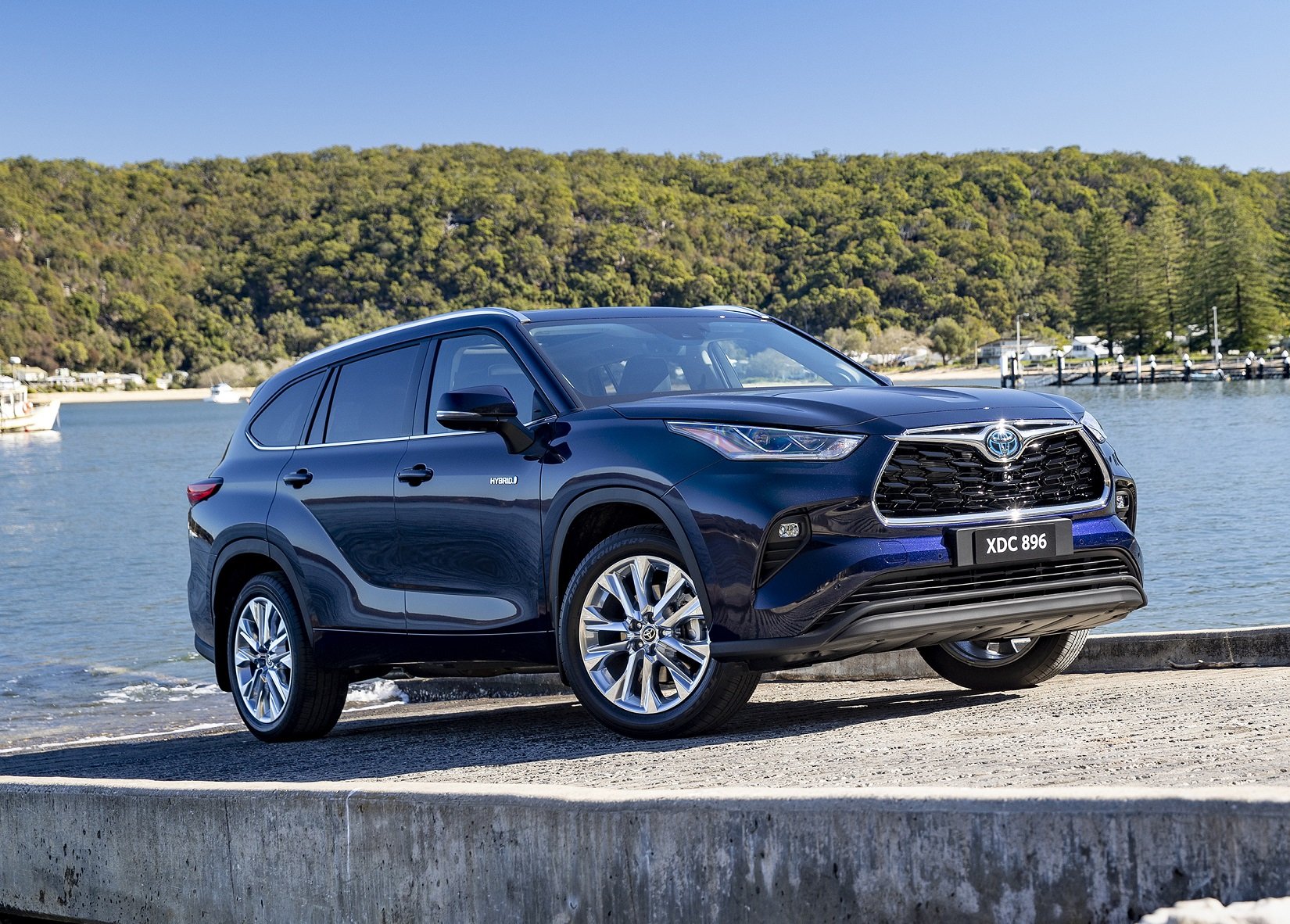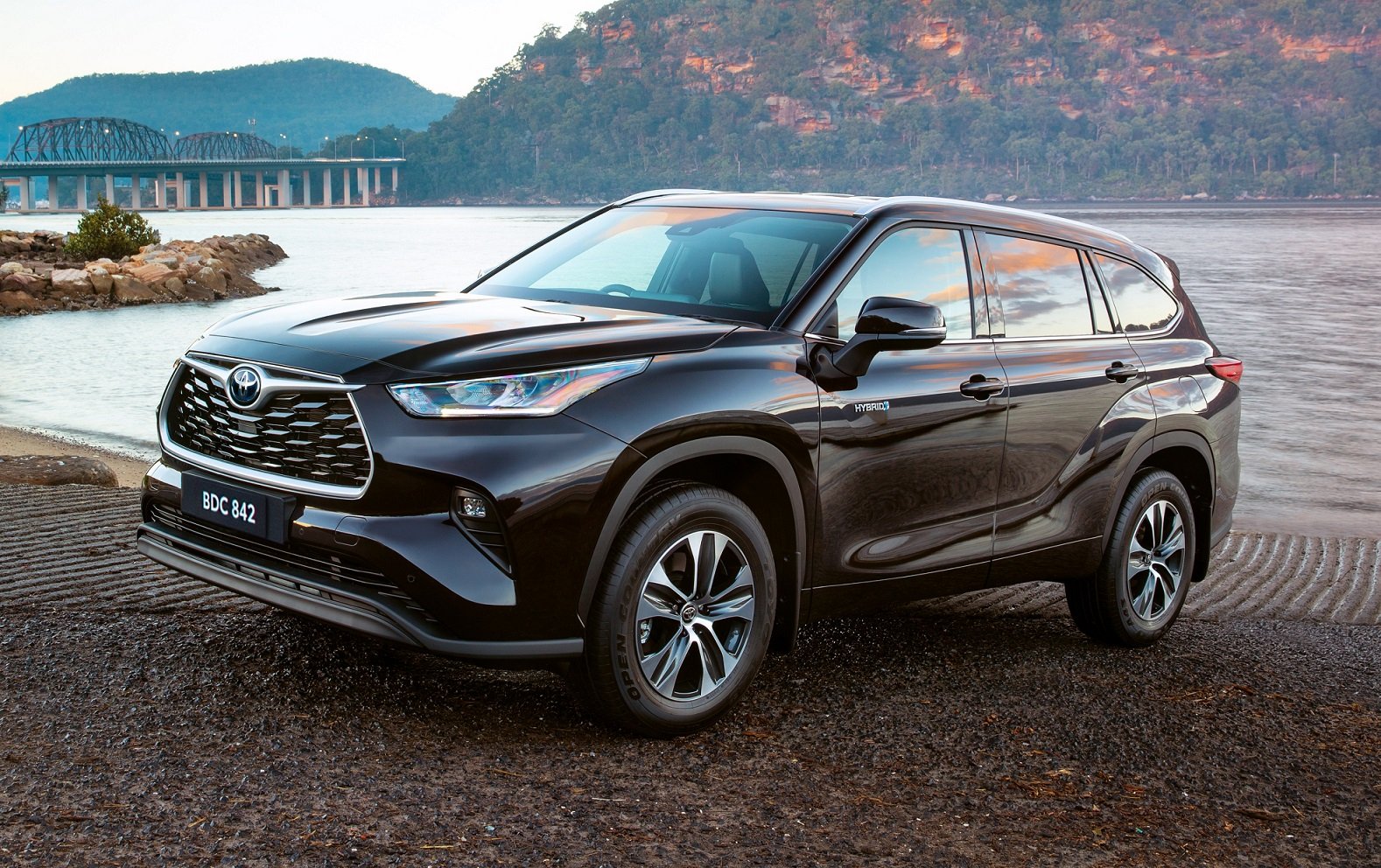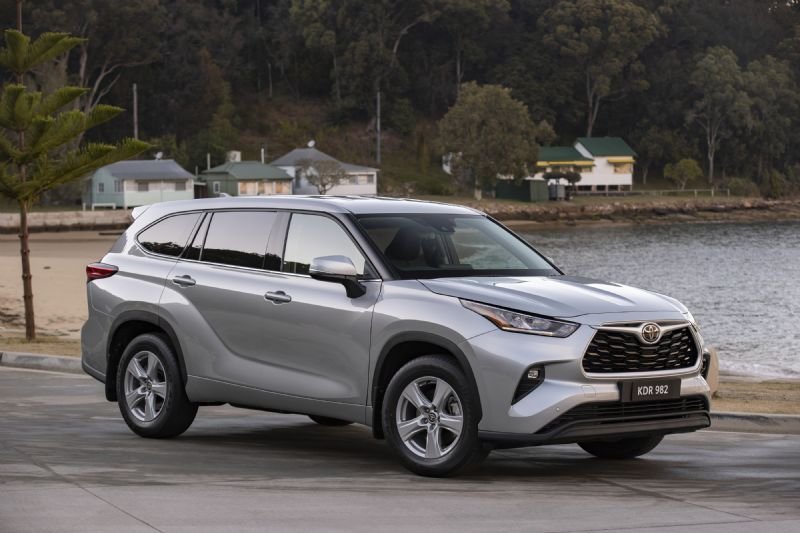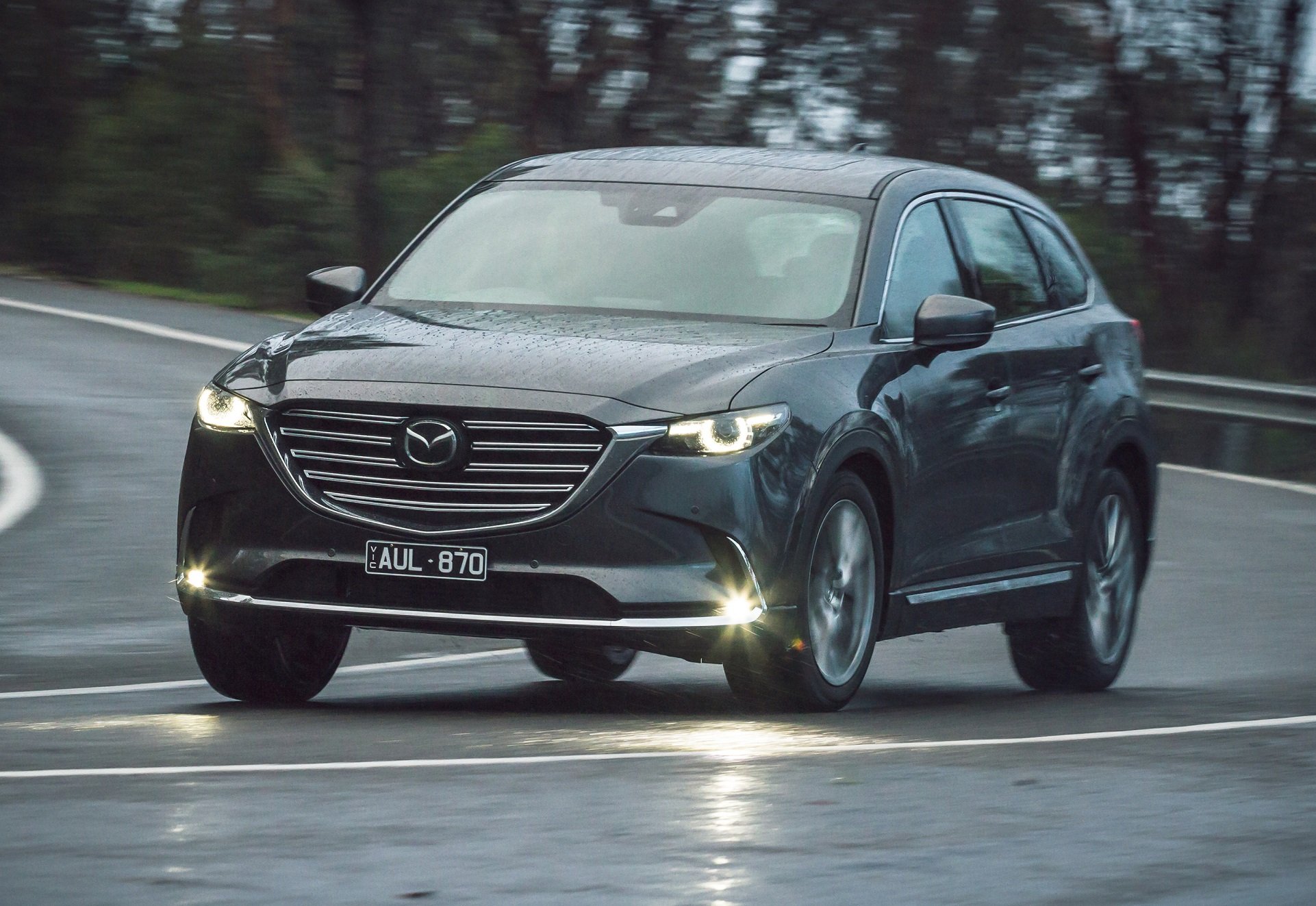Toyota Kluger review and buyer’s guide
Toyota is an Aussie religion that says you’ll (probably) buy a Kluger when shopping for a big 7-seat family SUV. But is devout popularity and resale value a good-enough, objective reason to make this very expensive choice?
Toyota Kluger is one of the most popular seven-seat large SUVs in Australia, but it’s also one of the most expensive.
Selling over 10,000 units in 2023, it was only beaten (and for the first time possibly ever) by the Subaru Outback. But does it have any right to be so popular?
Toyota is the king of mediocrity for a reason, and certainly that’s not always a bad thing, but when the highest model grade cost $90,000, questions need to be asked.
If you’re considering a Kluger, you’ll want to be shopping it against the Hyundai Santa Fe, Mazda CX-9 and CX-8, and the Kia Sorento. You might also consider a Mitsubishi Outlander among this company, albeit with substantially less legroom in row 3.
But before you whip out the credit card and drop your deposit on a Kluger simply because it says ‘Toyota’ on it, this report will be a fair, critical analysis of what makes it worthwhile as daily family transport, but also offers you the balance and nuance of highlighting its flaws.
Knowing what Toyota Kluger gets wrong is what will make your decision to buy one an informed choice, and a resolutely more logical, objective undertaking.
Sales of Kluger in 2025 are up 8 per cent, making it one of the top sellers of the large SUV non-4WD models. This is at a time when Subaru Outback is down 19 per cent, Kia Sorento is down 9 per cent, and Hyundai Palisade is down nearly 40 per cent (new model coming soon).
Kluger is third in the large SUV sales with 3489 units, behind the Subaru Outback in second with 3646 sales, and the Kia Sorento in first on 4198. Kluger also beats the Hyundai Santa Fe on 2637 sales thus far in 2025.
What’s interesting about Kluger’s struggles for sales domination, as happened with the previous version, is that at the same time this generation does not lead its rivals in popularity, the incoming market threat from Chinese brands like the Chery Tiggo 8 is substantial. The Tiggo 8 has only recently gone on sale in 2025 and is already selling hard and fast.
What does all this talk about sales figures mean to you, as a consumer? It means a couple of things, such as the fact there are now choices in the market, such as the Chery, the Outback, Sorento and Santa Fe which all represent better value than the Kluger - in many respects, not necessarily all.
Also, Kluger does have a miraculous ability to hold its value exceptionally well in the used market, so when you do come to re-sell yours in 5-10 years’ time, you’ll most likely get a little bit more than the other vehicles. This is most pertinent with the Chery Tiggo 8, which has a sale price so low that by the time it depreciates, it’s going to be selling for a significantly lower price than the Kluger, Outback, Sorento and Santa Fe.
If we use Redbook.com.au data to look at current trade-in price on a 2022 Kluger Grande eFour, the most optimistic selling scenario estimates a $58,900 trade-in price from an original purchase of $80,000. That’s 26 per cent in depreciation in just four years (inclusive). If you applied that grossly over-generous 26 per cent depreciation to the Tiggo 8’s $48,000 price tag (an MY2025 vehicle, remember), you’re looking at $35,520.
This means after four years, your Kluger at 66 per cent more to purchase, is worth about 40 per cent more than the upstart Chery Tiggo 8. That should tell you something about profitability and the value of Toyota in the current market. There’s a reason it’s the number one global carmaker - still.
Things can change, however, and they seem to be changing rapidly. There also needs to be something said for Toyota’s enormous dealership and technical footprint in Australia. Big feet = big shoes.
FEATURES & PRICING
Starting with price, Kluger GX hybrid was a $58,300 pill to swallow before applying on-road costs, but in 2024 that’s now a staggering $66,450. That’s an $8000 jump in about 18 months. For comparison, the brand-spanking new Hyundai Santa Fe hybrid starts at $63,600-ish and offers a comprehensively better all-wheel drive system and equally frugal hybrid 1.6-litre turbo-petrol powertrain.
Price increases track sharply upward another $8550(ish) to $76,350 for the GXL Hybrid. That’s up from $67,800 back in 2022-23, and hitting a dizzying $90,150 for the Grande, and that’s driveaway. You’re looking at a $23,700 price gulf between the base model and top-spec hybrid Kluger. There’s a reason people use the expression ‘Toyota Tax’ in Australia.
You can no longer have the Kluger as a 2.4-litre turbo-petrol four-cylinder all-wheel drive, which was $55,800 for the GX poverty pack, $65,300 for the mid-spec GXL, or $75,650 for the Grande - once upon a time.
You can only have the Kluger hybrid in 2024 onwards. That’s right, the combustion-only petrol-powered Kluger is gone.
All Kluger variants get a 2.5-litre naturally aspirated 4-cylinder petrol engine that uses a battery and electric motor capable of 42kW of power for a total combined output of 184kW. The engine on its own only makes 142kW, running on 95 premium unleaded. The only transmission available is the 6-speed CVT which we’ve seen used for many years now to reliable effect. More on the powertrain below.
Here is what you get on each model grade.
Kluger GX hybrid | $66,450 driveaway approx.
Key features:
LED headlights & taillights; foglamps
Heated electric mirrors
Cloth seat trim
7-inch driver’s dash display
Tri-zone climate control
Smartkey entry, push-button start
Adaptive cruise control, auto emergency braking, lane departure warning, auto high beam, cyclist/ped detection
Front & rear parking sensors, dynamic reversing camera guidelines
DAB digital radio, wireless Apple CarPlay & Android Auto, 8-inch infotainment touchscreen, 6-speaker stereo
Kluger GXL hybrid | $76,350 driveaway approx.
Key features added:
Roof rails
Electric tailgate
8-way power adjustable driver and front passenger seats, Driver and front passenger heated seats, Power driver seat lumbar support
Premium interior and door trims, ‘Plated’ door handles
12.3-inch infotainment touchscreen, satnav
Kluger Grande hybrid | $90,150 driveaway approx.
Key features to finish:
11-speaker JBL premium audio system
Panoramic View Monitor
Head-Up Display
Driver’s seat memory
Interior ambient lighting, Front door sill metal scuff plates
More premium soft instrument panel and door trims
Driver and front passenger heated and ventilated seats
Painted rear lower bumper, chrome plated grille trim
Panoramic glass moonroof
2nd row retractable sunshade
Power back door with kick sensor
Projector LED headlamps
Now, let’s rip into Kluger and sort the good from the bad - starting with sales volume, because that matters. You can download the Toyota Kluger specifications here >>
By end of 2023, Toyota sold/registered over 10,000 units, putting it at the top of five non-4WD large seven-seat SUVs like Hyundai Santa Fe, Kia Sorento, Mazda CX-9 and CX-8, Mitsubishi Outlander (technically mid-size), and Nissan Pathfinder. We’ll also include Subaru Outback here on another technicality, but it’s strictly a five-seater only.
Here’s how sales look for these models, when graphed:
Large SUV sales, full-year 2023
Outback and Outlander skew the results somewhat, so don’t incorporate them into your analysis here, because they’re cheaper and therefore will sell in greater volume. But they do offer segment perspective, and Outlander is a seven-seater, technically, while Outback has the overall length to classify as ‘large’ without actually being so.
The numbers were a truly pathetic 927 sales for the allegedly-new Nissan Pathfinder with its heavy, thirsty, old, American 3.5-litre petrol V6 which is comprehensively outclassed by every vehicle in this list.
RESALE VALUE
Arguably the best reason for buying a Kluger starts with one of the strong aspects of buying a Toyota in Australia generally - popularity.
This means that lots of people will want to buy that vehicle in the used market once you’re ready to move that vehicle on. Toyota enjoys very good resale values on most of its models, and the Kluger is no exception, thanks in part to Toyota being the biggest volume seller on a brand basis, and Kluger’s sales being so high.
A 2019 Kluger Grande AWD with the 3.5-litre V6 petrol engine under private sale today can reasonably expect to fetch $43,000-48,000, according to data from Redbook.com.au, when it sold for roughly $68,000 brand new. That’s 30 per cent in depreciation over four years, averaging between 60,000-100,000km at approximately 15,000km of driving per year - which is the average Australian motorist’s annual mileage.
A 2019 Mazda CX-9 Azami (same spec-level, from the next most popular brand’s equivalent vehicle), in 2023 can fetch $41,000-45,000 - again, according to Redbook data. A new one would’ve cost you about $69,000, and here lies the difference. Your depreciation is greater in the CX-9. Not by much, only a difference of a few thousand dollars and there is a strong argument for having bought the ‘better’ overall tool for the job - especially if you wanted to use row 3 routinely.
But the chances are you paid slightly more for your Mazda CX-9, and got a little bit less for it four years later, compared with a Kluger.
That same 2019 Kluger of the previous generation was nothing particularly special, either. It was a front-wheel drive or on-demand AWD, V6 Atkinson cycle petrol, seven-seater weighing two tonnes when empty. It wasn’t even made in Japan, it’s made in the US.
At best you’re looking at roughly 29 per cent depreciation if you sold privately for about $48,000 today with about 60,000km on it. The equivalent Hyundai Santa Fe Highlander 3.5-litre V6 petrol is selling privately for about $41,000 with the same mileage.
INTERIOR
Speaking generally on Kluger, it’s got plenty of space, in all three planes: headroom, legroom and shoulder room. The various controls and switches are all where you’d expect to find them on a right-hand drive SUV, and there’s very little in the way of ergonomic trip-ups. Certainly nothing worth booting it from your shortlist.
But you’ll be spending a lot of time in this thing, rpesumably, so take the time to fiddle around with the infotainment screen, connect your phone, change the radio station and have a crack setting/adjusting the cruise control on the freeway. Make sure there are no operability issues for you personally.
The sunvisor, for example, does not extend across the driver’s window unlike in a Kia Sportage or Hyundai Santa Fe. Does that annoy you? Does it do anything quirky you’d prefer otherwise? These are the kinds of meet-and-greet type interactions you need to have with any new car before you’re certain it’ll be right for you.
If you have child restraints, big prams and long cargo like 5-person tents and full-size eskis to pack for holidays, take a tape measure and see if they’re gonna fit in the boot.
With all rear seating collapsed (rows 2 & 3), there’s 1150 litres of cargo volume at your disposal in a Kluger. That’s 74 per cent less than what Kia Australia quotes for the Sorento at 2011 litres. Then with row 2 up, Kluger reduces to 552 litres, another 11 per cent less than Sorento. But it’s a different story with row 3 up: Kluger has 241 litres; Sorento 187 litres.
The wheelbase of Kluger is 2.85 metres long compared with the 2.81 metres on Sorento, which means there’s a negligible 35mm difference in interior passenger legroom. These vehicles are basically the same width and height, but the key size is length.
Kluger is 156mm longer than Sorento, which is where it gets those additional 54 litres behind row 3. But you’ll pay a premium for it. Not to mention, Kluger does seem to have a massive bonnet/frontal section that you need to park.
What Kluger gets very right in terms of being a seven-seater, is the frequency you can use row three with peace of mind that if you are involved in a serious crash, particularly a side impact, there are head protecting curtain airbags for row three. Rivals like the Hyundai Santa Fe and Kia Carnival also get row 3 curtain iabrgas. The current Kia Sorento (introduced in the lockdown years of 2020 doesn’t have row 3 curtains; it’s based on an older platform). Check out Which 7-seat SUV is Safest >> for more on that.
Mounted externally under the Kluger’s boot floor is a full-size spare alloy wheel and tyre, meaning that if you’re travelling with a boot full of luggage, camping gear, food and water, you don’t need to unpack the entire long weekend’s worth of supplies to access the spare in the event of a flat. Although you may need to remove a few things to lift up the floor and access the jack and associated tools, there is also a cover of the spare wheel to stop it getting plastered with filth. So that’s nice.
But it’s a bit disappointing Toyota has only bothered to put two ISOFix anchorage points in Kluger, on the row 2 outboard positions. Kia Sorento has one ISOFix position in row 3, and of course Kia Carnival is the only vehicle on the market with five ISOFix positions (three in row 2, two in row 3).
Nor are there even any top tether anchor points in Kluger’s third row. It’s big kids only up there, until their legs get too long.
When it comes to fitting a Type A rear-facing child restraint harness into Kluger’s ISOFix points (in row 2), ANCAP gave it a ‘poor’ mark. This is not the case with a Santa Fe, Sorento, CX-8 or Palisade. Generally speaking, a large 7-seat family SUV should not be having any red marks/’poor’ ratings for child restraints in the row 2 outboard seating positions.
These are the default primary passenger seats for any and all kids regardless of what restraint they’re using and for something as basic as a Type A restraint (Type A meaning rear-facing), there should be no questions or issues installing any restraints here.
Please note: this does not mean you cannot fit a rear-facing convertible seat in outboard row 2 seats. You absolutely can, it’s just going to be prudent for you to check that whichever restraint you have (or intend to buy) will instal correctly - before you sign the contract and pay for a deposit.
SAFETY
Kluger has a five-star safety rating which was achieved using 2021 testing protocols, and it scored quite well. You can download the Toyota Kluger’s full safety rating report here >> but to summarise, it scored neck-and-neck with its main market rivals.
Crash testing in the US saw the left-hand drive Grand Highlander (a stretched Kluger as we know it in AUstralia) get some less-than-perfect results regarding the front airbag, but which aren’t as applicable to the version we get here. In general, the IIHS rates Kluger/Highlander as acceptable in the small overlap (25 per cent frontal overlap) test.
The IIHS rates Kluger/Highlander as a 2024 Top Safety Pick with good scores in the small front overlap, moderate overlap (40 per cent) and side tests.
The reason the Insurance Institute for Highway Safety performs the ‘Small Overlap Test’ is because this kind of frontal crash is quite common in collated road crash data and it’s a particularly nasty crash where high inertial loads are concentrated on a very narrow 25 per cent frontal section of the vehicle.
ANCAP’s crash testing regime does not perform this test on models rated in Australia, but it does give us an indication that Kluger in general performs pretty well in this situation.
The one slight deduction from a flawless score was the rear passenger’s seatbelt where the lap section of the belt “moved from the ideal position on the pelvis to the abdomen”, which is sub-optimal. Kluger/Highlander earned a ‘marginal’ rating for this updated moderate overlap test, but still earns a decent result overall.
You might look at the ANCAP score as fantastic because it marked Kluger at 90 per cent in destructive crash testing - a total of 34.53 points out of 38. It’s a very good score for Kluger, as a family SUV. But it’s not all rainbows.
Kluger lacks a front-centre airbag. This is basically a curtain-style airbag that deploys from the driver’s seat to separate them from the front- passenger in the event of a side impact, preventing heads and limbs from colliding and causing potentially lethal trauma to the brain.
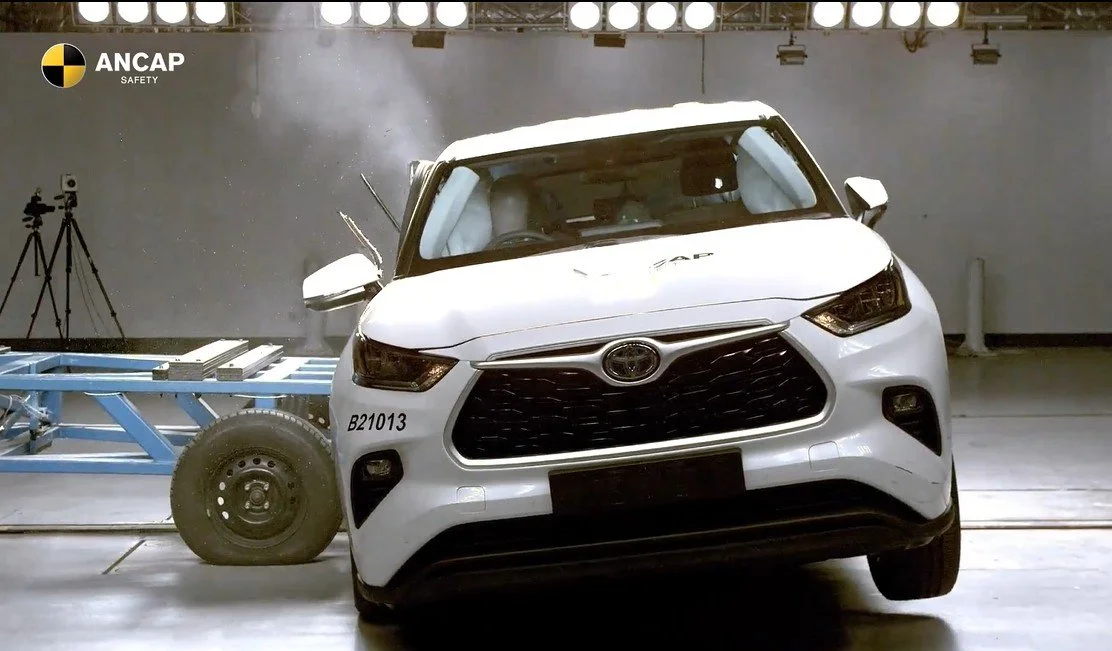
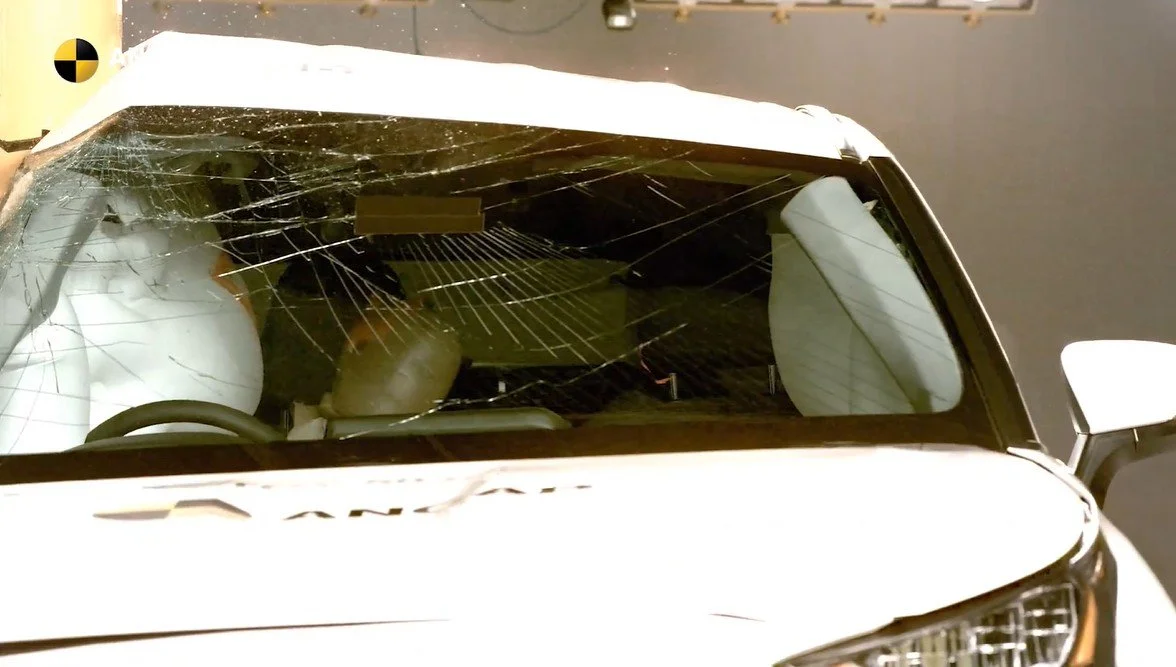
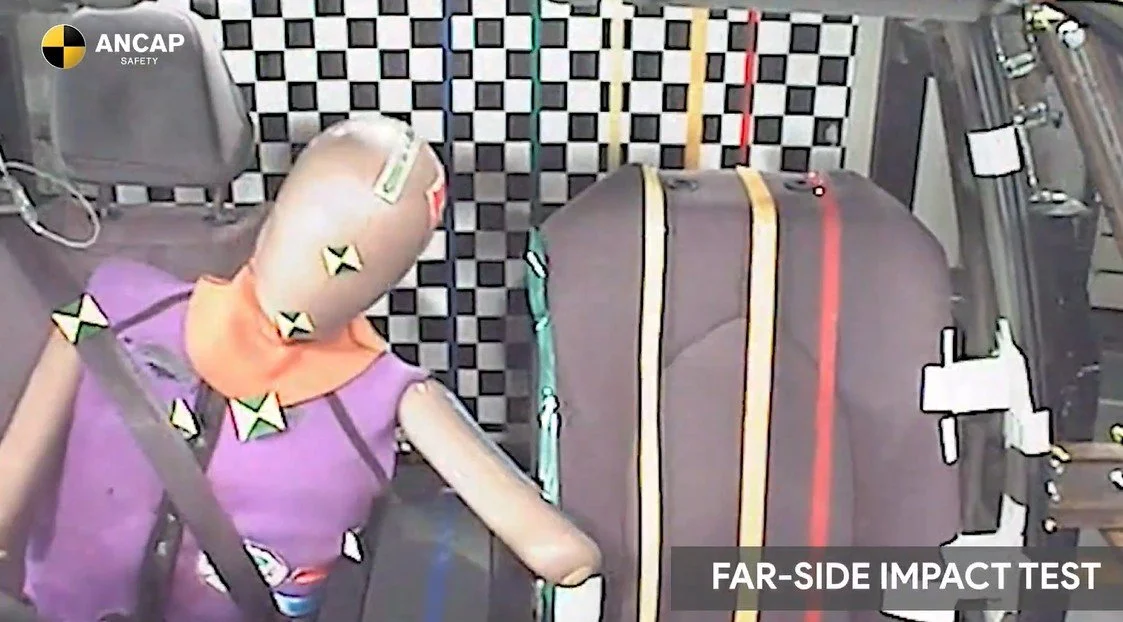
For many years, it was a bit of a maze trying to figure out which 7-seat SUVs came with third row curtain airbags. But carmakers are waking up to the fact this is a pretty poor look considering many brands will slap the ‘flagship’ moniker onto their big, expensive, luxurious 7-seat SUV.
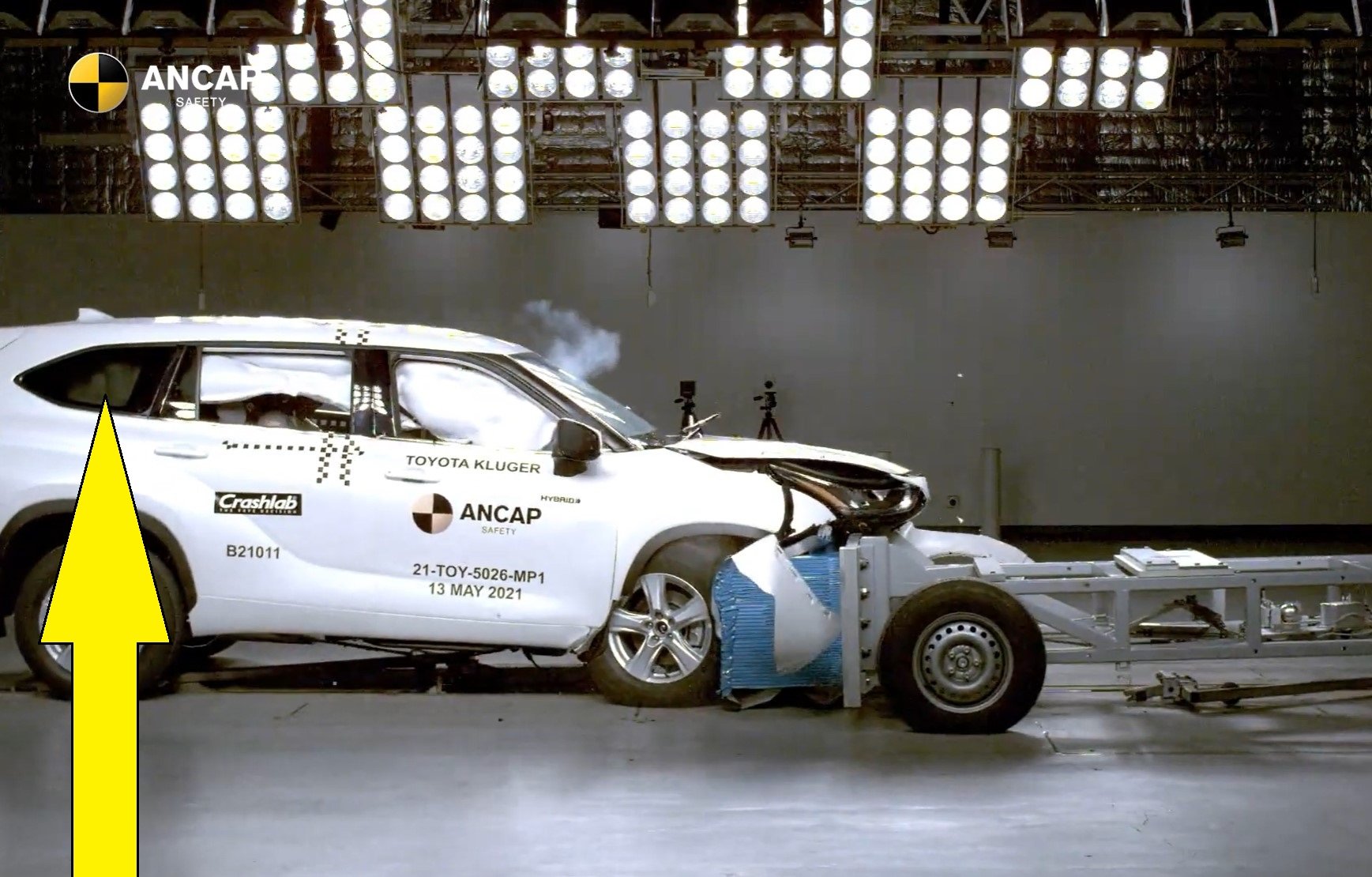
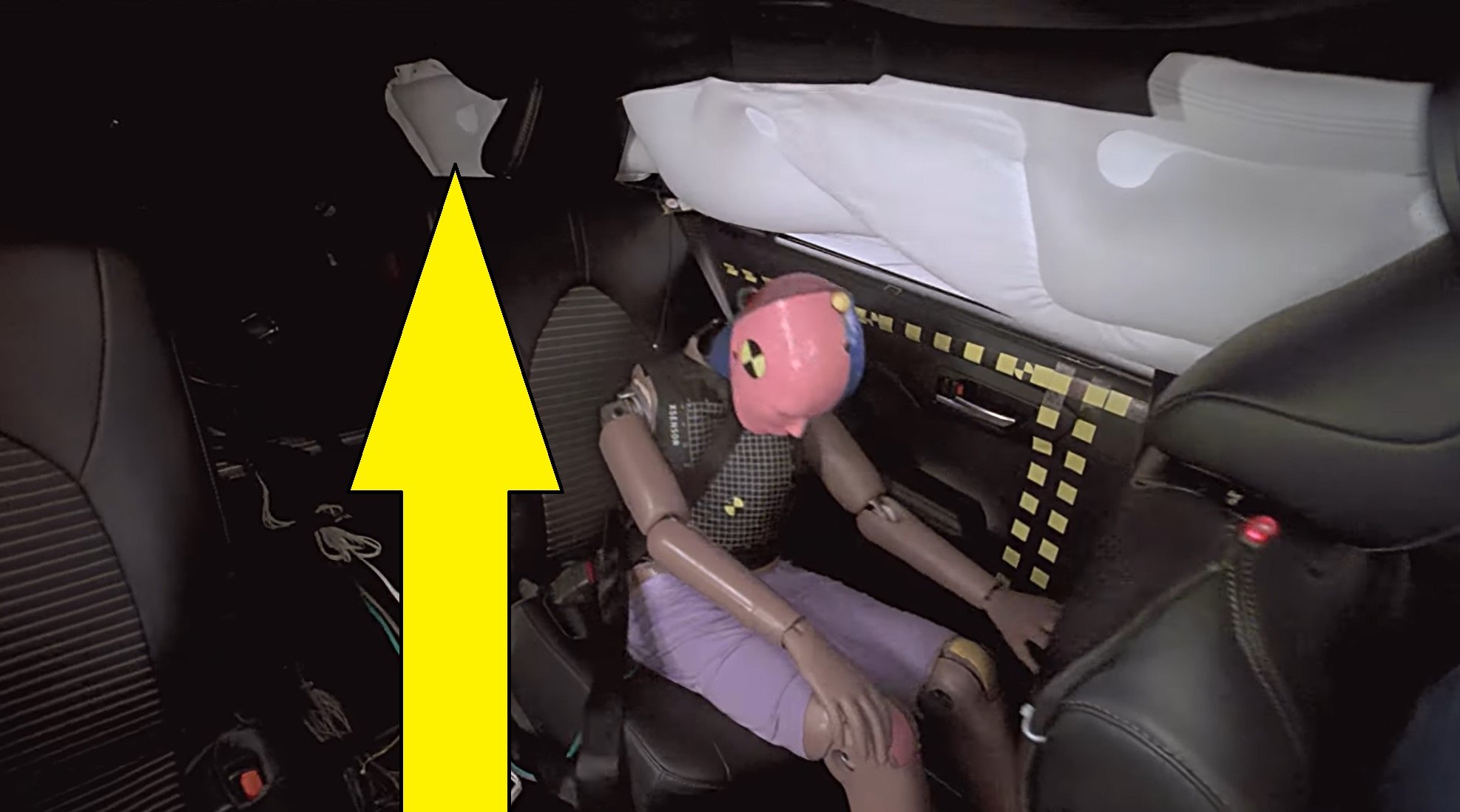
For balance, Kluger does include head protecting curtain airbags in row three for passengers in seats 6 and 7. This is a safety paradox, because it is an accomplishment, but depending on how you intend to use this vehicle, it’s also unfortunate they’ve not bothered with the front-centre.
Ultimately, the driver is always going to be present in the vehicle, obviously. But you could post a strong argument that row 3 is less likely to be full of kids in the unlikely event of a crash. Row 2 being literally in the middle of the likelihood of being occupied, with the driver and front passenger being statistically the most likely to have occupants.
And before launching its new Kluger, Toyota had the design of this vehicle in development for several years (as all carmakers do). Meaning, it had plenty of opportunity to make a front-centre airbag possible. But they’ve chosen not to, which is a permanent design that cannot be altered in the future. Not to mention, ANCAP and its crash-testing affiliates like EuroNCAP and the IIHS (in the US) make their testing protocols public long in advance.
This is typical of Toyota’s lack of innovation at a corporate level. They do the absolute minimum when it comes to updating an old model, or designing one from scratch. Every other carmaker has known and put the R&D budget in place to make front-centre airbags possible in their new models. But Toyota hasn’t.
If you have a big family and their safety is more important than yours, and you intend to use every rear seat as often as possible, then their safety is assured. But it is more likely that you as the driver will be the one impacted, literally.
Lastly, Kluger does not get tyre pressure monitoring, even on the top-spec, $80,000 so-called ‘Grande’, despite the fact all its major rivals have it as standard on their base models now. If Toyota wants you to get the best fuel economy, especially on its allegedly eco-friendly hybrids, surely keeping your tyre pressures optimised would be a top priority.
Not only this, tyre pressures are a safety factor. It doesn’t matter how many ‘safety assist’ features they make standard, the first basic dynamic safety upgrade you can make to your vehicle is to run on the correct pressures at all times, because those features can only intervene and do so much on under-inflated tyres.
DRIVING
There’s a phenomenon that happens when America builds vehicles that make it into discerning markets like Australia’s. See, Australia has crap roads, but we also favour good handling because we spend a lot of time driving owing to our sparse population - and sometimes we have to dodge wildlife.
Kluger is built in the US, but gets a very light once-over to make it right-hand drive and comply. But it’s lumped with a turbocharged petrol four-cylinder engine as the default choice for tight budgets. This is because Americans are obsessed with gasoline for moving their big, heavy pick-up trucks and large SUVs. This is due to their taxation system that makes diesel more expensive than ‘gas’, but they are, of course, wrong - because diesel fuel offers about 30 percent more energy for the equivalent unit of petrol/gasoline.
And Toyota uses the Atkinson cycle, which favours fuel economy, not performance.
Toyota’s turbo-petrol four-cylinder is murdered by the Mazda 2.5 turbo-petrol, which makes the CX-9 go like stink while still being refined, smooth and dripping with torque.
So diesel engines provide more motive power to move bigger, heavier vehicles more efficiently than gasoline. This is why Kluger feels like an overweight hulk to drive. Because it’s got the wrong engines under the bonnet.
Also a legacy of the American factor is the ultra-light electric steering tune, which favours numbness over weight and feel. Toyota’s nature as a severe cost-cutter means that Australians don’t get a bespoke steering or suspension tune for our driving conditions unlike Hyundai and Kia which invest in making Santa Fe and Sorento actually nice to drive.
Having softer suspension means three things. First, when you steer into a corner, the body leans over more, taking weight off the tyres providing grip. Secondly, if you need to swerve suddenly to avoid hitting a kangaroo or something, it takes the vehicle milliseconds longer to respond, and has the potential to unsettle the vehicle dynamically. Now, this isn’t a serious problem with Kluger - in fact it drives and rides quite okay, it’s certainly acceptable - it’s just not quite as precise as a Mazda CX-9, Santa Fe or Sorento.
Thirdly, softer suspension does make for a more comfortable ride over speed humps, potholes and broken roads, but there is a point at which being too soft can become uncomfortable. This happens when the dampers aren’t doing much work and the vehicle takes a long time to recover. Kluger doesn’t get this way, but it could do with some slightly firmer suspension for better dynamic roadholding, particularly on regional roads.
Having said that, many drivers (possibly yourself included) may not notice or care much how a new car handles. A great many new car buyers are happy with ‘close enough’, and that’s not a criticism, nor is it a bad thing. The majority of ordinary people probably wouldn’t notice the difference between how a Sorento, Santa Fe, CX-9 or Kluger drive, dynamically.
Generally speaking, seven-seat SUV buyers drive at suburban speeds and want maximum luggage space, legroom and features for their money - and that’s perfectly okay. In this regard, Kluger is certainly a decent-enough choice. It’s just not exceptional. It’s mediocre, and for plenty of people, that’s good enough.
The hybrid powertrain combines all-wheel drive and it’s okay without being great. The small battery and electric motor are fairly smooth and get going up top about 40km/h quite effectively, until the somewhat lacklustre 2.5-litre petrol 4-cylinder kicks in. And it does ‘kick’ if you need to get up to speed quickly, especially with a bunch of kids and their sports bags on board.
But the turbo-petrol is certainly the more unrefined powertrain, needing 6000 revs to provide peak power to move Kluger’s two tonnes of heft. The 2.2L diesel in a Sorento offers 140kW at more like 2000 revs - much better suited.
The transmissions are a CVT on the hybrid and an eight-speed epicyclic automatic on the turbo-petrol. The CVT is not bad, but can be a bit prone to rev spiking when it changes down to overtake (spoiling fuel economy), where a turbo-diesel 4-cylinder would be smooth and offer better low-RPM power. The eight-speed auto robs some of the power due to the torque converter process, meaning it makes a nice gargling sound while not going any better than the old Kluger V6.
I'll help you save thousands on a new Toyota Kluger here
Just fill in this form.
No more car dealership rip-offs.
Greater transparency.
Less stress.
ENGINE
There were two engines in the Kluger: a 2.4-litre 4-cylinder which is naturally aspirated (no turbocharging), and a 2.5-litre hybrid-petrol engine. But now, Australia only gets the hybrid.
The term ‘Hybrid’ means joining an internal combustion engine to a battery-electric drivetrain. Hybridisation is a way of capturing energy. When your foot lifts off the accelerator to coast or simply brake to slow down, the hybrid system captures some kinetic energy to store in a battery, using that energy to assist the vehicle in accelerating again when the lights change.
In Kluger, the hybrid engine costs about $4500 more than the combustion-only equivalent, which is a fairly substantial jump in price, but okay - it makes sense if the hybrid is the superior powertrain. But is it?
Let’s see if that matters and if the hybrid does enough fuel saving to offset the additional $4000 you would spend on buying it versus the combustion-only version.
In the case of the Kluger eFour Grande, according to the official laboratory-standardised ‘Combined Cycle’ fuel consumption test, the saving is about 35 per cent. Your mileage may vary, obviously, but that’s a decent fuel saving, on average. The hybrid gets 5.6 litres per 100km for the combined cycle, and the combustion-only gets 8.7.
Hybrid Kluger takes 95 RON premium fuel, whereas the atmo Kluger takes 91.
If 91 fuel costs $2 per litre, and you rack up the Australian average annual mileage of 15,000km, it’s going to cost you $1680 per year. In 15,000km of annual driving you’re unlikely to ever record 5.6L/100km in the real world, so this is being extremely generous.
In the first two years, that $4000 could’ve bought you 2000 litres of 91 petrol at $2 per litre. That’s 29 68-litre tanks of 91 RON unleaded, at $136 per tank. Based on the atmo Kluger’s 8.7L/100km fuel consumption, that $4000 could’ve driven you, notionally, 22,600km.
In the hybrid, you’re going to pay more like $2.20 per litre because it takes 95 premium fuel, which gives you a notional 63-litre fuel tank range of 1122km (average), costing roughly $138 per tank. Driving that same 22,600km as the atmo Kluger, it would take 20 tanks of fuel, costing $2760 - that’s an apparent saving of $1240.
But you paid $4000 more to start saving that per year - so it’ll take about 3 years to break even, and only then do you start saving 15 cents per litre or $9.45 per tank. That’s $189 per year, but only from the end of the fourth year of ownership, at which point you’ve driven 60,000km.
But you’re only going to be getting that fuel economy benefit if you’re using the regenerative braking system - otherwise, on the freeway, the battery and motor become a weight penalty. So that 60,000km could be much more in the context of real-world driving. And the quoted fuel economy figures by carmakers are always dubious, because the ‘combined cycle’ test is a standardised bench test, meaning the actual figure you get will differ.
The reason for the hybrid’s better fuel economy figure is that it uses multi-point fuel injection which preferences economy. The ‘atmo’ engine makes its power by revving really hard to 6000RPM - which is exactly how you don’t want to drive a big SUV with kids on board, all juggling food and school bags.
But paying $4000 more upfront for the hybrid means you’re financially behind from the beginning. If you commute on the freeway to work, the hybrid battery won’t be working as much.
Kluger’s atmo 4-cylinder is the tight-budget option, but the hybrid runs on premium fuel, so the cost savings are somewhat mitigated unless you’re using Kluger in metro city areas where the small 88kW battery is being consistently recharged using regenerative braking.
A Kia Sorento GT-Line diesel is about $11,500 cheaper than a top-spec Grande Kluger hybrid at $80K before on-road costs, which means you’re financially ahead before the fuel economy starts to play a part. The problem for Kluger here is the Sorento diesel’s fuel economy figure is 6.1 L/100km on the combined cycle - only 8 per cent better.
This means it’ll take, notionally, 168,000km for the hybrid Kluger to break even with the Sorento in the same conditions. On a freeway, the diesel wins on fuel economy because it is more energy dense than petrol, even in a Kluger hybrid. So the figures are 5.3 vs 5.6 (Kluger).
Excluding the fuel tanks, Kluger Grande is 4 per cent heavier than a diesel GT-line Sorento. Even when you do count the fuel tanks which are neck and neck on weight/size, Sorento is lighter, makes more power (where it counts: low RPM, where most people drive normally), and goes better, costing you less overall.
So if your budget truly is tight, get a diesel Sorento instead and pay as little upfront as possible to begin with.
TRANSMISSION
Kluger uses a ‘Continuously Variable Transmission’ or CVT, which is much like the Kluger itself - not bad, but not excellent.
It goes okay, it changes gears nicely, is generally pretty intuitive at holding or changing up or down when appropriate, and being a CVT it’s always trying to offer you peak power, which in turn helps in the pursuit of fuel economy.
It also uses an on-demand all-wheel drive system, meaning it primarily run in front-wheel drive until it detects high throttle input or wheelspin.
On-demand AWD is not necessarily a bad thing. But it can be a bit reactive, at which point it can be too late in some instances if you’ve broken traction and cannot afford to slip backwards, such as on a boat ramp. A front-wheel drive needs to start slipping before the AWD system kicks in, meaning there’s already limited grip available to take advantage of. Hence it can be too late by suddenly redirecting drive to the rear wheels.
However, if it’s a case of the tyres simply being overwhelmed by the amount of tractive effort going through them (based on throttle input), splitting that drive to the rear reduces the wheelspin you’re going to generate in the front. So it can still work to get you out of a spot. It’s just not as efficient or smooth as an active AWD system that is constantly using all four wheels, like a Subaru, Mitsubishi, Hyundai or Kia.
Kluger’s hybrid AWD system uses an electric motor at the rear to rotate the rear wheels, rather than a driveshaft, so it is quicker than that older design, to be fair.
DRAWBACKS
It’s okay to love Toyota, Australia’s most popular religion. But in order to make an informed purchasing decision, let’s look at the objective facts the brand would rather you ignored when dropping a potential 80 thousand big-ones on a Kluger.
PRICE
If you’re going to spend over $80,000 on a hybrid Kluger, with even the suggestion of ‘saving money on fuel’, you’re not thinking rationally about this. With the cents you’ll save on fuel in stop-start traffic (where the battery kicks in), it will take you several years and over 100,000km before you’ll get close to breaking even.
Compare this price premium to just buying even an ordinary combustion-only Kluger GXL or something, where there’s $6500 price difference between the hybrid AWD and the straight-combustion GXL front-wheel drive. $6500 buys you about 3500 litres of unleaded, roughly.
If you’re on a budget, the Kluger doesn’t actually offer you a great deal more over an equivalent Kia Sorento, Hyundai Santa Fe or Mazda CX-9, but it does depend on what you need the vehicle to do. Kluger is a reasonable light-medium towing option, but Toyota fails to state in its specifications sheet what the towball download limits are, so that’s a concern.
A GXL offers a decent features list without blowing one’s mind. Electric tailgate and driver & passenger seat adjustment, heated front seats, satnav, the 12.3-inch touchscreen - over and above the GX which already gets auto wipers, tri-zone climate control, adaptive cruise control, heated electric folding mirrors and foglamps.
DELAYS
The worst aspect of going through the process of buying a Kluger is the Toyota production stuff-up. They simply cannot seem to fix their epic supply problem despite nearing the end of four years of ongoing excuse-making and PR buzzwords about “unprecedented global demand”.
This has nothing to do with demand and everything to do with Toyota’s failure to be prepared for market disruption. They started this downward race to stiff parts suppliers on price (particularly computer chip suppliers) and all it took was one global market hiccup to put Toyota’s epic tight-arse manufacturing process under immense pressure, the likes of which they may never recover from.
If you put a deposit down on a Kluger, it could be as long as 12 months until you actually see the vehicle you bought - and even then they cannot guarantee you it’ll be the one you actually wanted. Having said that, it’s RAV4 Hybrid and LandCruiser 300 most affected by Toyota’s ineptitude here, and less-so for Kluger. But don’t be expecting miracles.
HYBRID POWERTRAIN
If you think buying a hybrid is going to save you money from the moment you set off, this is almost a marketing con. Sure, you will save a sip of fuel every time you accelerate from stationary up to about 25-30km/h, until which point the combustion engine kicks in. This is the general operation of a typical Toyota hybrid, what’s known as ‘parallel hybrid’, whereby a small battery relies on regenerative braking to charge it, and/or the engine.
The main problem with these kinds of hybrids is they rely heavily on the engine to recharge the batteries, which is a thermodynamics fail, because it would be more efficient to simply use that fuel to propel the vehicle. This is because every time you do a process, you lose available energy as a result, and this is an objective fact that applies to the entire universe; it’s not just an opinion.
What the parallel hybrid does offer as an advantage is electrical propulsion in what is the most consumptive step of the combustion engine’s operation, acceleration. It takes a much greater amount of fuel (and therefore emissions) to get a 2.1-tonne Kluger from stationary (at the lights, say) up to 60km/h than it does to go from 60-100km/h. So using a battery and AC motor/s in this 0-40km/h stage is a good idea, reducing emissions and saving you those few cents on fuel with every stop-start event.
And Kluger hybrids demand you use 95 RON premium fuel, so you’re locked into that aspect as well; already paying more for petrol.
This is why a hybrid makes sense in high-density city traffic, where the battery can do as much of the heavy lifting as possible and it gets recharged frequently. Except Toyota uses ancient nickel-metal hydride battery tech, which is as old as the hills by modern standards. The tiny battery in Kluger makes just 88kW and cannot deliver enough power to drive the vehicle over distances, which is why it needs to be constantly topped up.
Compare this with the Kia Sorento PHEV which weighs exactly the same as a Kluger Grande, costs the same, but has a big lithium-ion battery capable of 150kWh and can be charged at will by plugging it in at home after delivering about 50km of average commuter driving without ever having to use the combustion engine and emit from the exhaust.
But once you’re on the freeway trying to get up to cruising speed, that battery and AC motor aren’t doing any work, in fact they’re a liability on the combustion engine. They must be. Just like any bags of concrete, children or unnecessary gym weights should be left at home and tyres appropriately inflated.
This is the point at which you should be aware of ‘plug-in hybrid’ powertrains available in other models, like a Mitsubishi Outlander PHEV, where you can run in EV-only mode all day during the morning city commute, and revert to combustion mode on the weekend out to your favourite winery or down to the beach.
Any time you hear the term ‘self-charging’ just remember that’s Toyota’s marketing bullshit trying to sell you on some magical notion that its cars are like some kind of perpetual motion machine, which of course cannot work. Toyota is behind the 8-ball in terms of EV/hybrid innovation and it wants you to think its hybrids are pseudo electric cars. They’re not.
TOYOTA’S REPUTATION
Toyota has been sponsoring the footy since forever ago and sells itself as the virtuous, trusted, dependable brand that Aussies love - but that polished reputation is starting to fade for multiple reasons.
The LandCruiser 300’s twin-turbo V6 has an excessive oil consumption problem within just two years of going on sale, yet is being heralded as a champion of reliability and an engineering triumph by the motoring media generally. So much for that Toyota indestructability.
Not only did Toyota lie to over 216,000 Australians about its dodgy DPF system in the 2.8-litre diesel Hilux, Fortuner and Prado, but they also tried referring to them as ‘guests’, not customers.
This emissions-cheating saga extended to Toyota’s sub-brands Hino and Suzuki which are under the prosecutor microscope internationally.
Of course there’s Toyota’s pork-pie hybrid self-charging marketing efforts which tried to sell you on the idea that its Corolla, Camry and RAV4 Hybrids were some magical perpetual motion type of propulsion. Toyota tried to suggest Australians were to dumb or lazy to plug in their vehicles to charge. But look how that’s turned out, with a bunch of EVs coming onto the market and EV sales increasing significantly in the last two years.
Then there’s Toyota’s ‘Oh, what a paint-peeling’ problem due to poor paint procedures on hundreds, possibly thousands, of 10-year-old vehicles.
They’ve also received heat from the 4WD community over sub-standard brakes and refusing to replace discs that have been prematurely chewed out - a situation made very public by 4XOverland’s Andrew St. Pierre White.
Toyota is/was also rationing smartkeys as another knock-on effect of their supply chain production ineptitude.
CONCLUSION
Kluger is not a bad vehicle. Despite my sincere criticisms in this report, it’s actually a pretty reasonable option for seven-seat large family transport - especially if you’re not one for crunching numbers or comparing specifications. And that’s genuinely not a mocking of you or that potential consumer. Most new car buyers have much better, more important things to do than over-analyse cars.
Most people just want a decent, reliable, well-built family bus for getting life done, and that often means people like you don’t have time to dig deep on vehicle features and specs.
But it’s a bit of a half-hearted effort, the Kluger, unfortunately. It’s mediocre - not bad, not excellent, it’s just okay. There are a number of things they could’ve done to make Kluger that bit more competitive, and more polished, but they haven’t.
It depends on your budget as to which model grade you can afford, but GXL is usually a pretty good option for those who have a healthy budget but with limitations that allow for a few of the necessities without splurging.
Kluger is a ‘good enough’ large SUV for people who don’t want to think too hard about which one to buy. The fact it has a Toyota badge on the front is often the key selling point for a great many consumers. And that’s okay.
Toyota generally makes good vehicles, they’re pretty reliable and the customer support is usually okay, often thanks to its massive dealer network and large onshore parts inventory.
A Kluger is not a cheap vehicle, but then no seven-seat large SUV is in today’s market, and Kluger certainly helps simplify the buying process.


